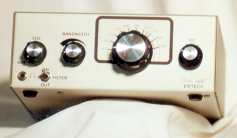
VA3JEG
Amateur Radio Page
Hello, my name is James Garratt, and I live near Kleinburg, Ontario, Canada.
Thanks to all who have visited this site. I'm recently back from a disastrous computer crash, and now should be able to regularily update this site.
I presently operate, very economically, on 2 meter FM, and HF. My equipment includes an ADI 2 meter mobile unit, Ten-Tec 2m handy-talky, Ten-Tec Century 21 HF rig (now out of commission), Emtech NW20 QRP rig (20 meters),
I also treasure a Swan 350C (vintage tube radio I got at a hamfest), and use a Radio Shack DX 160 for shortwave listening.
I use a Loop Skywire (full-wave on 80 meters) and a 20 meter dipole for HF. For my 2 meter base I use a roof-mounted quarter-wave groundplane antenna. All my antennas are homebrew.
As an environmentalist, I believe in the principles of green radio. To keep my station as environmentally friendly as possible, I have designed it to be powered by solar-charged batteries (needless to say, it is a challenge to power the Swan with batteries, but I'm in the process of weening it off AC. Presently I use an DC to AC inverter, but plan to acquire a Swan DC converter module). I also try to adhere to the amateur's rule of using minimum RF power to establish contact. To further conserve power and also for esthetic and traditional reasons, I operate mainly with a mechanical Vibroplex Lightning Bug 
I do, however, also have a Heathkit HD1410 keyer.
I feel that the use of high-power (say, greater than 100 watts) in amateur radio is justified only in emergency situations.
My father, Richard Garratt, served as a radio operator for the Royal Canadian Navy during WW2 aboard the frigate Glace Bay. He ignited my interest in radio at an early age. I remember him fiddling with crystal radios, particularly those type that were shaped like a rocket-ship. Later, he introduced me to shortwave listening. When I finally decided to get my amateur licence in 1996, I was surprised to find that even after 40 years away from a key, my father could still send and receive Morse. Practicing with him helped me to pass the code test on my second try.
Now that the code has been devalued in amateur licencing requirements, I can only hope that newcomers will not miss out on this fascinating, 'human-scale' mode. Morse code in radio is analogous to the canoe or sailboat, or fly-fishing: Steeped in tradition, history, and with very practical advantages beyond its perceived quaintness.
The aura of mystery around radio intrigues me. For all our high-tech gadgetry and scientific knowledge, radio remains essentially mysterious, especially on the quantum-mechanical level. I plan to explore some of the seemingly mysterious happenings, events, circumstances and coincidences relating to amateur radio. Have you experienced any of this 'mysterious' quality yourself?
I will be updating this page regularly with links, commentary, and graphics.
STAY TUNED!
Updated: July 3, 2000.
Visit my HOME PAGE
Return to QSL Net home